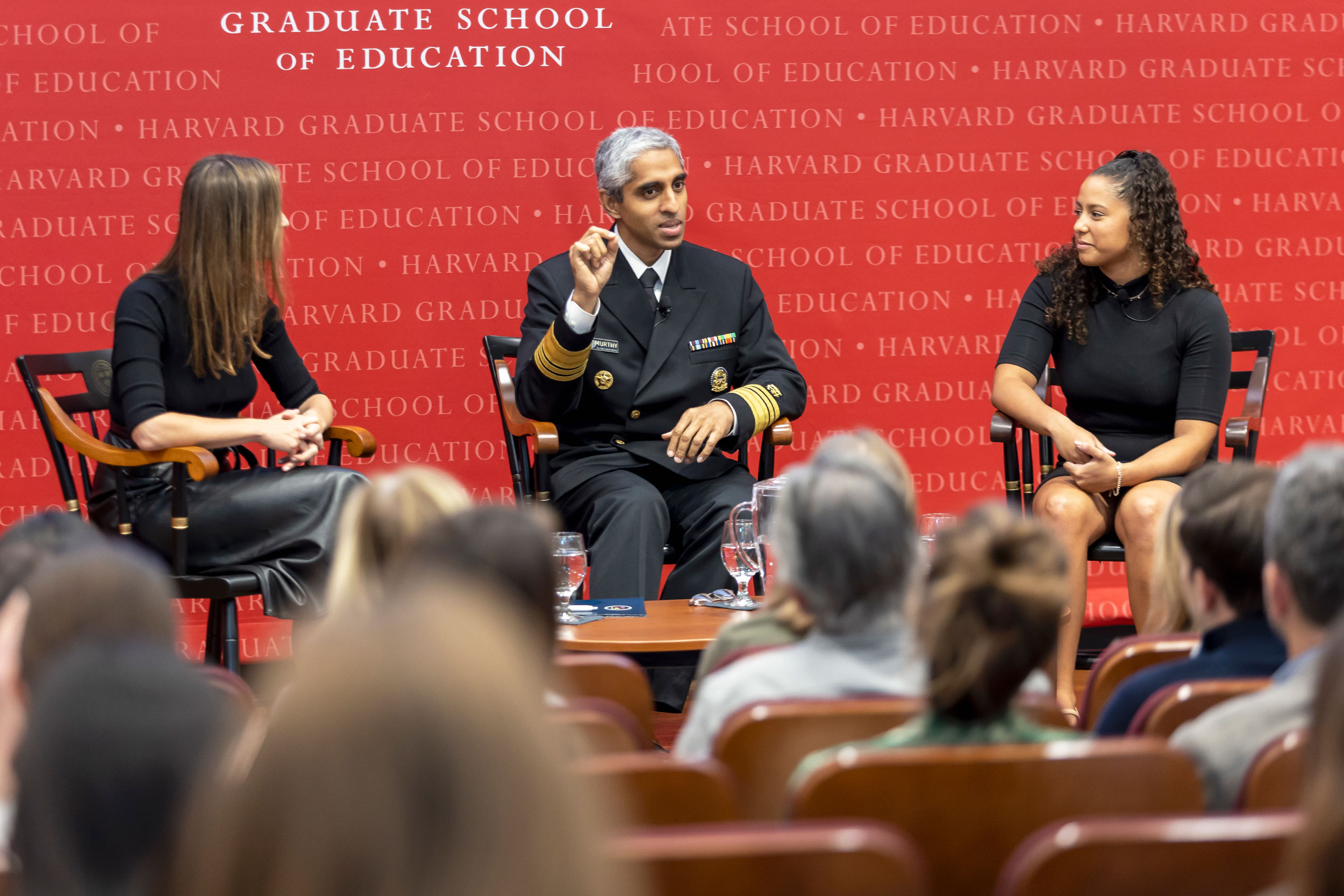
U.S. Surgeon General Vivek Murthy (center) spoke at the launch of the GSE’s Center for Digital Thriving with moderator Emily Weinstein (left) and Destinee Ramos ’26.
Jill Anderson/HGSE
Murthy says social media hurting kids, time for government, tech firms to help
Surgeon general calls mental health risks ‘pivotal issue in public health’
It’s time for government and private industry to step up and reduce the mental health risks of social media for young people, according to U.S. Surgeon General Vivek Murthy.
Murthy called the impact of digital platforms on teen well-being a “pivotal issue in public health” during an event last Friday afternoon marking the launch of the Center for Digital Thriving at the Harvard Graduate School of Education. Up till now the burden has been placed on parents, he said, but it’s clear that resolving the problem will require a broader effort.
A 2022 survey found that teens, on average, spend 3.5 hours a day on social media, but a more recent poll found that the average could be as high as 4.8 hours. A survey showed that children and teens who spend more than three hours a day on social media double their risk of developing anxiety and depression. It is a concerning picture, said Murthy.
Just as safety standards made driving safer by requiring seatbelts, airbags, car seats, and crash testing, policymakers should act based on a safety-first approach and set up guidelines to protect children’s privacy and welfare, said Murthy. Technology companies also should be held accountable for not doing enough to mitigate the harms social media pose to children’s mental health and well-being.
“If we don’t put safety standards in place and provide more support for young people and their parents, we’re going to look back five, 10 years from now and say, ‘What were we thinking?’” said Murthy.
“We’ve unleashed this force into the country without any guardrails, without any follow up, without any accountability,” he said. “We have fallen short when it comes to taking care of kids with regard to social media and safeguarding them against harms. We’ve got to close that gap.”
Social media platforms emerged nearly 20 years ago, and the lack of guidelines to safeguard children’s mental health and safety is alarming, said Murthy, who took part in a conversation hosted by the Askwith Education Forum with Destinee Ramos ’26, research assistant on teens and digital well-being at the center. The event was moderated by Emily Weinstein, the new center’s co-director and principal investigator at Project Zero.
“We have fallen short when it comes to taking care of kids with regard to social media and safeguarding them against harms. We’ve got to close that gap.”
Vivek Murthy, U.S. surgeon general
“Everywhere I traveled across America the most common question I was getting from parents was about social media,” said Murthy. “What they wanted to know was very simple: ‘Is social media safe for my kids?’ And they were not getting an answer even though millions of children are on social media.”
In May, the U.S. Surgeon General issued an advisory, the first-ever government report on social media and youth mental health. The report included data that rendered a disturbing picture.
Among them was a survey that found that nearly half of adolescents said being on the digital platforms made them feel worse about their bodies. Another showed that six out of 10 girls said they were approached by strangers on social media in ways that made them feel uncomfortable. All the data highlighted that young users are exposed to bullying, harassment, extreme violence, and hate speech, which can lead to depression and anxiety.
Safety standards should be put in place by both policymakers and technology companies, but until that happens, parents can establish some safeguards, such as creating tech-free zones for children and their families, said Murthy. Children can also regulate their social media use, block unhealthy content, and take breaks from their phones. Educators can also help train both young people and parents in digital literacy.
“There’s really nothing that’s helping young people understand the content that’s coming at them or how to navigate it,” said Murthy. “How do you recognize when there’s something that’s making you feel poorly? How do you even know that you should be monitoring how you’re feeling, and then responding to that? What tools do you have available to help you alter your experience and make it healthier? These things are very difficult for people to understand and just figure it out on their own.”
With the growing demands for social media companies to take accountability, there is also a greater sense of agency and awareness among teens about their social media usage, said Ramos.
“I’ve talked to so many teen girls and teens in general, who are really excited to be regulating their own usage and be able to speak up and understand what exactly it’s doing for their lives and their experiences,” said Ramos, a College sophomore. “It makes me very hopeful that teen girls and teens in general are realizing this completely and taking agency in their own usage.”
The recent approval of the California Age-Appropriate Design Code Act, which sets safeguards for children and teenagers online, as well as the increasing calls for tech companies to implement age-appropriate design, make Murthy feel hopeful too. But the problem remains pressing.
“Our job, as parents, educators, and just people who care about children, is to make sure that they have a foundation on which they can build a healthy and fulfilling life, and that means creating a healthy, safe digital experience for children,” said Murthy. “That is where I feel we need to continue to make this an urgent issue.”




